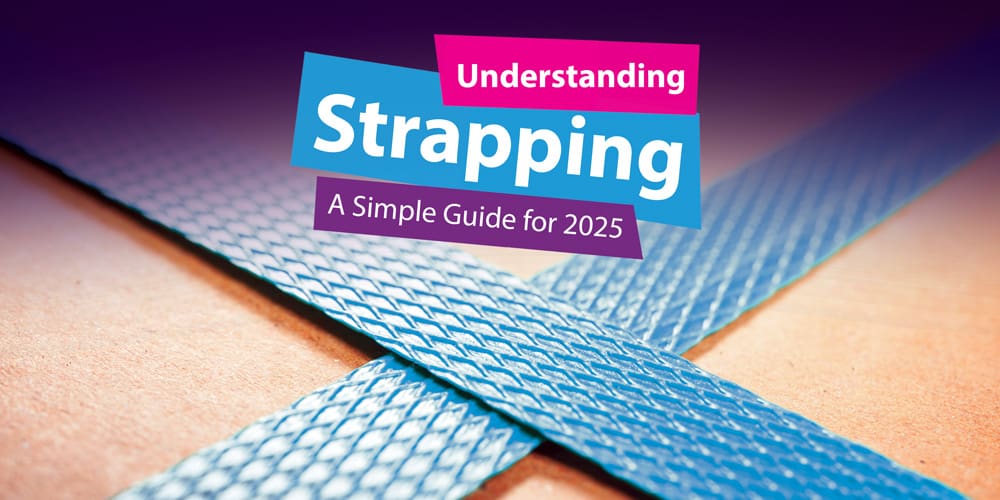
Table of Contents
What Is Strapping and Why Use It?
Strapping is a durable and reliable material used to secure items together, particularly during storage, handling, and transport. Strapping is used for bundling boxes, reinforcing pallet loads, or stabilising bulky or irregularly shaped goods, strapping plays a critical role in keeping products tightly held in place. It helps prevent movement, shifting, or tipping during transit, which in turn reduces the risk of damage caused by impact, vibration, or stacking pressure.
Strapping is commonly applied using manual tools or automated machines and comes in various materials such as polypropylene, polyester, and steel, each suited to different load weights and handling requirements. For example, lightweight plastic strapping may be ideal for securing cartons, while heavy-duty steel strapping is often used in construction, manufacturing, and shipping of industrial equipment.
By improving load stability and keeping goods intact throughout the supply chain, strapping enhances safety, reduces product loss, and contributes to more efficient transport and storage operations. It’s a simple but essential solution for any business involved in packing, shipping, or warehousing.
Types of Strapping
Composite Polyester Strapping
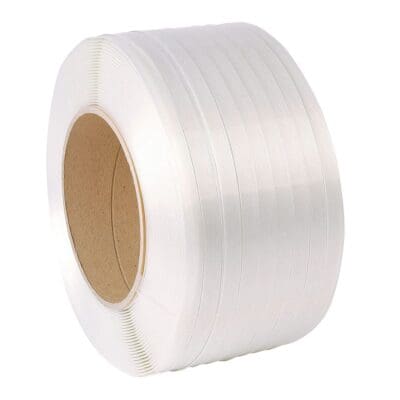
Composite strapping is made from polyester fibres coated with plastic. It offers high strength and is safer to handle than metal strapping. The rigid structure makes it easy to feed under pallets and around loads. It also resists water, sunlight, and most chemicals.
Features:
- Shock-resistant and longlasting
- Safer to handle than steel
- Can be applied with hand or battery tools
- Holds tension over time
What is the difference between woven and composite strapping?
Woven strapping is made by weaving plastic threads tightly together to form a strong strap. It is flexible and can stretch a little.
Composite strapping has a polyester core covered with plastic. This makes it very strong and resistant to cuts and weather but less stretchy than woven.
How long does composite strapping last?
Composite bonding can last for several years if the strapping is stored and used correctly. It resists rust and damage from sunlight better than steel.
However, its lifespan depends on how much pressure it holds and the conditions it faces like heat or moisture.
Composite Polyester Strapping Breaking Strain Range:
Composite Polyester Strapping products:
13 mm wide: approximately 290 kg
16 mm wide: approximately 410 kg
19 mm wide: approximately 450 kg
25 mm wide: approximately 785 kg
34 mm wide: approximately 1400 kg
Polyester Strapping

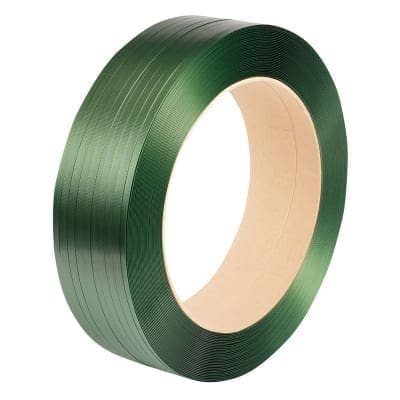
Used for heavy or irregular loads. It keeps its tension well, making it suitable for long-distance transport. Polyester strapping is flexible, recyclable, and less likely to snap under pressure.
Tensioners and Serrated Seals are commonly used to secure it in place. For best results, apply it tightly using a manual or battery-operated tool. Polyester is known for its high breaking strain and strength retention.
Features:
- High tensile strength: Ideal for securing heavy or rigid loads
- Shock-absorbent: Retains tension and resists load movement during transit
- UV and weather resistant: Suitable for outdoor storage and export
- Safe to handle: No sharp edges; reduces risk of injury
- Recyclable: More eco-friendly than metal strapping
- Works with metal seals or friction weld tools: Versatile application options
How to use Polyester Strapping
First, wrap the poly strapping around the box or pallet. Make sure the strap is flat and not twisted. Then bring the ends together.
You can seal it with a buckle, seal, or use a strapping tool to hold it tightly. Check the strap is secure so nothing moves during transport.
What is the difference between polyester and polypropylene strapping?
Polyester strapping is stronger and holds tension better, making it better for heavy loads. It also stretches less, so it keeps things more secure.
Polypropylene is lighter and easier to work with, but not as strong. It is better for small boxes or lighter loads.
Dangers of polyester strapping?
Polyester strapping can snap back if it breaks while under tension. This can cause cuts or bruises if it hits someone.
Always wear gloves and safety glasses when applying or cutting the strap. Make sure to use the right tools to stay safe.
Breaking strains
Breaking strain means the most weight a strap can hold before it snaps. Polyester has a higher breaking strain than polypropylene.
Polyester Strapping Breaking Strain Range:
- 12 mm wide approx. 250–350 kg
- 15 mm wide approx. 400–600 kg
- 16 mm wide approx. 550–700 kg
- 19 mm wide approx. 700–850 kg
25 mm wide can reach 1,000 kg or more
Note: The strength also depends on the type (smooth or embossed), quality, and if it’s used with seals or friction weld tools. Polyester strapping has excellent tension retention and is often chosen as a safer alternative to steel for heavy loads.
Other types of Polyester Strapping
Embossed polyester strapping has a textured surface. The pattern helps the strap grip better when sealed, so it doesn’t slip.
Hotmelt cord polyester uses polyester cords held together by a special hotmelt adhesive. This makes the strap strong and flexible.
Steel Strapping

Steel strapping is typically used for heavy-duty loads like bricks, timber, or metal pipes. While very strong, it has sharp edges and can be harder to handle. It does not stretch and is suitable for very rigid products.
Because of its weight and risk of injury, many now use polyester or composite options in its place. Still, for certain heavy applications, steel remains a reliable option.
- Maximum strength: Best choice for very heavy or solid loads like bricks, timber, or metal
- Minimal stretch: Holds firm without losing tension over time
- Heat and flame resistant: Suitable for use in extreme industrial environments
- Ribbon or oscillated wound: Compact coil types for easier storage
- Very high breaking strain: Often above 1000 kg for industrial use
- Requires careful handling: Sharp edges can pose a safety risk
What is the alternative to steel strapping?
Polyester and composite strapping are popular alternatives to steel. They are lighter and easier to use while still being strong.
These options are safer to handle and do not rust or leave sharp edges like steel can.
Dangers of Steel Strapping
Steel strapping has sharp edges that can cut hands or arms if not handled carefully. It can also snap back when cut under tension.
Always use safety gloves and goggles, and handle it with the right tools to avoid injury.
Breaking Strains
Breaking strain is the amount of weight a strap can hold before it snaps. Steel has one of the highest breaking strains.
It is important to pick a strap with a breaking strain that suits the weight of your load.
Steel Strapping Breaking Strain Range:
- 13 mm wide around 560kg
- 16 mm wide around 730 kg
- 19 mm wide up to 1700kg or more
Polypropylene Strapping

Polypropylene strapping is lightweight and used mostly for securing light cartons or bundling small items. It is available in different widths and colours and is easy to apply. It can be sealed using heat, buckles, or friction tools.
It is also recyclable and cost-effective. However, polypropylene straps can fray if not handled properly, so careful storage and cutting are important.
- Lightweight and flexible: Easy to handle and apply by hand or with a dispenser
- Cost-effective: Budget-friendly solution for general packaging needs
- Suitable for bundling and palletising: Ideal for boxes, parcels, and light loads
- Available in reels or coils: Can be used with hand tools or semi-automatic machines
- Variety of colours and widths: Customisable for branding or load ID
- Recyclable and moisture resistant: Suitable for indoor storage and dispatch
- Breaking strain varies by width and thickness: Choose based on load weight
Can be sealed with buckles or heat: Flexible sealing methods
Is Polypropylene Strapping Recyclable?
Yes, polypropylene strapping is recyclable. It is made from a type of plastic that can be melted down and reused.
To recycle it, check your local recycling rules and keep it clean and dry before disposal.
Breaking strains
Breaking strain means how much weight a strap can hold before it snaps. Polypropylene has a lower breaking strain than polyester or steel.
Most polypropylene strapping holds up to 300 kilograms, depending on its width and thickness.
Polypropylene Strapping Breaking Strain Range:
5 mm wide (machine strapping): approximately 60 kg
9 mm wide (machine strapping): approximately 140 kg
12 mm wide (machine strapping): approximately 145 kg
12 mm wide (hand strapping): approximately 300 kg
15 mm wide (hand strapping): approximately 300 kg
16 mm wide (hand strapping): approximately 350 kg
How to keep polypropylene straps from fraying
To stop the ends from fraying, cut the strap cleanly with a sharp tool. Some people melt the end slightly with heat to seal it.
Also, store the rolls in a dry, cool place and avoid rough edges that can damage the strap during use.
Choosing the Right Type
Application | Best Type |
Bundling Light Boxes | |
Heavy Loads or outdoor | |
Rigid industrial materials | |
Medium to heavy duty shipping |
Strapping Seals Compatibility Table
Lap Over Seals
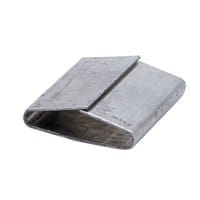
Lap-over seals are different from other types of strapping seals because they work by folding one end of the strap over the other and crimping it tightly. This makes them very strong and slip-resistant, so the load stays secure.
Semi-Open Seals
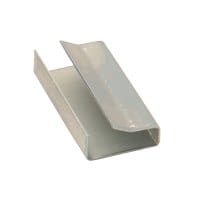
Semi-open seals are small metal clips used to hold the ends of strapping together. They are called “semi-open” because one side of the seal is open, which makes it quick and easy to attach with the right tensioning tool.
These seals are best for lightweight or medium loads, where speed is important and heavy-duty strength is not needed.
Serrated Strapping Seals
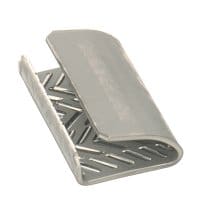
Serrated strapping seals are metal clips with small teeth that grip the strap tightly. The teeth help the seal hold the strap firmly and stop it from slipping, even under movement or vibration.
These seals are strong and work well for medium to heavy loads, especially when you need extra security.
Steel Strapping Buckles
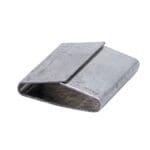
Lap Over Seals
The strap is threaded through the buckle, and then tensioned with a tool to hold the load tightly. These buckles are very strong and secure, making them suitable for heavy or rigid loads like timber, bricks, or metal pipes.
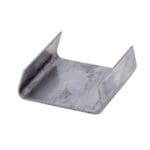
Snap-on Seals
A snap-on steel buckle seal is a quick and reliable fastening method used with polypropylene or polyester strapping to secure loads during transit and storage. Made from high-strength steel, these seals are designed to be applied without pre-threading, allowing the strap to be placed directly into the open buckle and then crimped using a manual or pneumatic sealer tool.
Sheradised Lashing Buckle
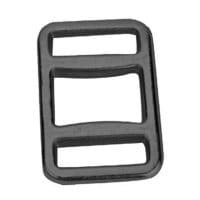
The strap is threaded through the buckle, and then tensioned with a tool to hold the load tightly.
These buckles are very strong and secure, making them suitable for heavy or rigid loads like timber, bricks, or metal pipes.
Sheradised Strapping Buckles
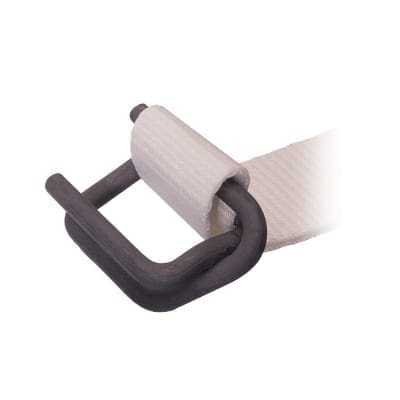
Sherardised strapping buckles are metal clips coated with a protective layer to stop rust and corrosion.
The strap is fed through the buckle and tightened with a tool, keeping the load secure.
These buckles are strong and long-lasting, making them ideal for heavy loads or outdoor use, where moisture or weather could damage regular metal buckles.
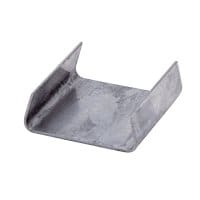
They are easy and fast to use, making them suitable for light to medium loads where speed is important.
While not as strong as lap-over or serrated seals, snap-on seals keep the strap secure during transport and are ideal for situations where you need a simple, quick way to bundle or palletise items safely.
This table provides a quick reference to help you select the right strapping seal for your packaging needs.
It outlines the types of seals available, their dimensions, compatible strapping materials, and key usage notes, making it easier to match seals with your tools and strapping types for secure and efficient bundling.
| Seal Type | Dimensions | Compatible Strapping | Notes |
|---|---|---|---|
| Semi-Open Seal | 16mm x 32mm 12mm x 25mm 12mm x 32mm |
Polypropylene | Used with TST30 tensioner and SGP16 & SG12 sealers |
| Lap-Over Seal | 32mm x 57mm | Steel or Polypropylene | Used with FPH tensioner and SAS32 crimper |
| Serrated Seal | 19mm x 30mm | Polypropylene and Polyester | Slip-resistant grip for secure hold |
| Snap-On Seal | 16mm x 25mm | Steel | Quick application for bundling and palletising |
| Lap-Over Seal | 16mm x 25mm | Steel | Designed for demanding load securing |
| Serrated Seal | 16mm x 30mm | Textured/Embossed Strapping | Enhanced grip under tension |
Final Thoughts
Knowing what strapping is used for helps you choose the best option for your job. From securing lightweight packages to holding heavy pallets together, the right material makes a difference. Using the correct tools and technique also ensures safer and more reliable results.
Need help choosing the right Strapping for you? Contact our team to get you on the right track!
Tel (NI): 028 4175 4977
Tel (Dublin): 01 866 0136
Email: sales@hub-packaging.com